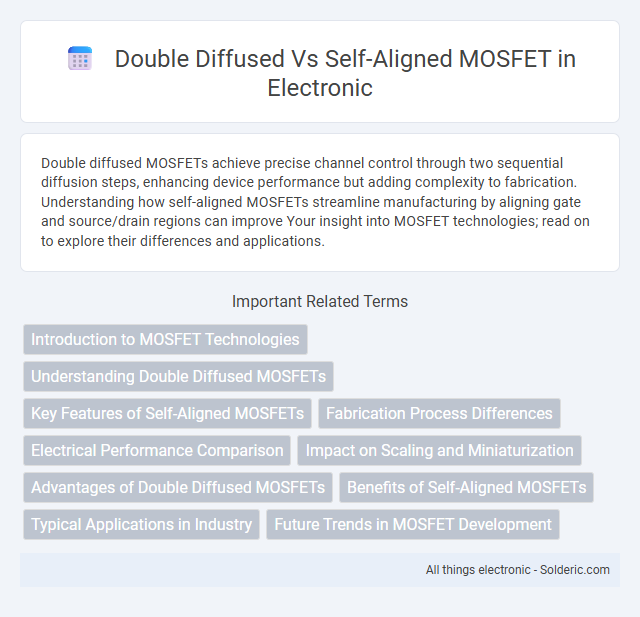Double diffused MOSFETs achieve precise channel control through two sequential diffusion steps, enhancing device performance but adding complexity to fabrication. Understanding how self-aligned MOSFETs streamline manufacturing by aligning gate and source/drain regions can improve Your insight into MOSFET technologies; read on to explore their differences and applications.
Comparison Table
| Feature | Double Diffused MOSFET (DMOS) | Self-Aligned MOSFET (SA MOSFET) |
|---|---|---|
| Structure | Diffused gate region using two diffusion steps | Gate aligned precisely with source/drain via self-alignment process |
| Manufacturing Process | Complex, involves multiple diffusion steps | Simplified, reduces parasitic resistances |
| Gate Control | Less precise gate alignment | High precision gate alignment improves performance |
| Electrical Performance | Higher gate-drain capacitance, slower switching | Lower capacitance, faster switching speeds |
| Application | Power devices, high voltage applications | High-speed digital and analog circuits |
| Cost | Higher due to complex fabrication | Lower due to simplified fabrication |
Introduction to MOSFET Technologies
Double-diffused MOSFETs (DMOS) utilize a two-step doping process to create a graded channel with enhanced current-carrying capability and reduced on-resistance, making them ideal for high-power applications. Self-aligned MOSFETs employ precise photolithographic alignment to minimize gate-to-source and gate-to-drain overlap, improving switching speed and reducing parasitic capacitances. Understanding the differences in fabrication techniques helps optimize your device selection for performance, efficiency, and application-specific requirements.
Understanding Double Diffused MOSFETs
Double Diffused MOSFETs (DMOS) feature a distinctive fabrication process involving two successive diffusion steps to create a lightly doped drain region, significantly reducing the on-resistance and enhancing current handling capabilities. This double diffusion technique results in superior electrostatic control and improved breakdown voltage compared to conventional MOSFETs. DMOS transistors are widely utilized in power electronics where high efficiency and robust thermal performance are critical.
Key Features of Self-Aligned MOSFETs
Self-aligned MOSFETs feature a fabrication technique where the gate electrode precisely aligns with the source and drain regions, minimizing parasitic capacitances and enhancing device performance. This alignment reduces overlap capacitance, leading to higher switching speeds and improved frequency response compared to double diffused MOSFETs. The self-aligned process also enables better scaling, lower gate resistance, and enhanced reliability in modern integrated circuits.
Fabrication Process Differences
Double diffused MOSFETs (DMOS) utilize a two-step diffusion process involving separate p-type and n-type regions to form the channel, requiring precise alignment of diffused layers during fabrication. Self-aligned MOSFETs employ the gate electrode as a mask to align the source and drain implants accurately, reducing parasitic capacitances and improving device performance. The self-aligned process streamlines fabrication by minimizing lithographic alignment errors, enhancing scalability and yield compared to the double diffusion method.
Electrical Performance Comparison
Double Diffused MOSFETs (DMOS) typically exhibit higher on-resistance and slower switching speeds compared to Self-Aligned MOSFETs due to their less precise gate alignment, resulting in increased parasitic capacitances. Self-Aligned MOSFETs offer superior electrical performance with lower gate-to-channel overlap, reducing threshold voltage variability and enhancing high-frequency operation. Your choice depends on application needs, but for high-efficiency and fast-switching requirements, Self-Aligned MOSFETs generally provide better electrical characteristics.
Impact on Scaling and Miniaturization
Double Diffused MOSFETs (DMOS) face challenges in scaling due to their complex diffusion profiles, causing increased parasitic capacitances and limiting channel length reduction, which hampers miniaturization efforts. Self-Aligned MOSFETs employ precise gate alignment techniques that significantly reduce overlap capacitance and short-channel effects, enabling aggressive scaling and enhanced device density. The self-aligned structure's superior control over the channel region makes it the preferred choice for advanced semiconductor nodes targeting nanoscale miniaturization.
Advantages of Double Diffused MOSFETs
Double Diffused MOSFETs (DMOS) offer superior current handling capabilities and lower on-resistance compared to Self-Aligned MOSFETs, making them ideal for high-power applications. Their structure allows for better control of the channel length, enhancing the device's efficiency and reducing conduction losses. You benefit from increased thermal stability and improved performance in switching and amplification tasks.
Benefits of Self-Aligned MOSFETs
Self-aligned MOSFETs offer superior electrical performance due to reduced parasitic capacitances and minimized channel length variation, enhancing switching speed and device reliability. The precise alignment of gate electrodes with source and drain regions lowers series resistance, improving overall current drive capability. Your circuits benefit from higher efficiency and scalability, making self-aligned MOSFETs ideal for advanced semiconductor technologies.
Typical Applications in Industry
Double diffused MOSFETs (DMOS) are widely used in power switching applications, such as motor drives, power converters, and audio amplifiers, due to their high voltage handling and robust structure. Self-aligned MOSFETs offer superior switching speeds and are favored in integrated circuits for digital logic and RF amplification, particularly in microprocessors and communication devices. Industrial automation and consumer electronics heavily rely on DMOS for high power control, while self-aligned MOSFETs dominate in low-voltage, high-frequency applications.
Future Trends in MOSFET Development
Future trends in MOSFET development emphasize enhanced scalability and performance, with Self-Aligned MOSFETs gaining traction due to their reduced parasitic resistances and improved switching speeds compared to Double Diffused MOSFETs. Innovations in materials and fabrication techniques aim to minimize short-channel effects and power consumption, securing the role of Self-Aligned MOSFETs in next-generation high-frequency and low-power applications. Your choice of MOSFET technology will increasingly rely on these advancements to meet the demands of evolving semiconductor devices and integrated circuits.
Double Diffused vs Self-Aligned MOSFET Infographic

 solderic.com
solderic.com